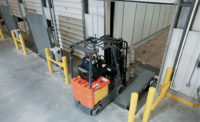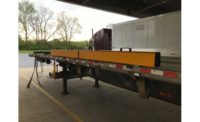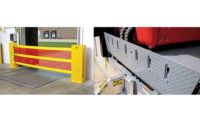Loading docks are a key part of any warehouse or factory that regularly moves products in and out of the facility. The perpetual movement of people, equipment, and merchandise through these spaces can create a dangerous environment for staff and visitors. What does it take to design a safe and efficient loading dock?
Choose the size best suited for the facility’s needs
Designing a functional, safe, and efficient loading dock starts with choosing the size that’s best suited for the company’s needs.
Start by assessing the receiving and dispatching requirements of the company and its workflows. How many incoming and outgoing trucks will this dock need to service during a given week? What sort of trucks will be handling transportation?
In North America, standard docks are expected to be 48 inches off the ground. Truck heights can range anywhere from 40 inches for small box trucks to 52 inches or more for shipping trailers.
Exploring dock ratings
Dock ratings will also come into play when designing a safe and efficient loading dock facility, but the precise details will depend on the materials coming in and going out.
Companies that are in the business of receiving specific chemical inventories will need to explore dock ratings. In extreme cases, it may become necessary to create an H-rated space. This type of designation may require additional features such as fire protection and containment measures.
Maintain the space
The physical design is only one part of the equation. Maintaining the loading dock over time is also essential to creating a safe and efficient working space. This includes:
- Removing any trash or other debris
- Ensuring adequate lighting, both natural and artificial
- Repairing any damage as it occurs
- Not allowing a buildup of pallets awaiting pickup or storage
- Maintaining paint or safety markings on walls and floors
There are a lot of straightforward steps that the average business owner can take to make their loading dock safer for everybody who interacts with it. Simple things like preventing the buildup of trash or other debris that could create a tripping hazard, or ensuring that any existing safety markings are visible and easy to see, can help improve workplace safety.
Manage moisture and humidity
It isn’t always possible to avoid foul weather, since no one has yet found a way to control Mother Nature. With that in mind, it’s essential to take the necessary precautions to prevent water from building up on the loading dock.
Standing water will create a slip and fall hazard. It can also damage equipment and merchandise and promote mold, mildew, and algae growth. Work with your team to design the loading dock with plenty of water drainage features included.
Setting these drains directly into the freshly poured cement is often the best option. Companies can also bring in a contractor to assess the drainage options and make changes to keep water off the loading dock. If humidity is a concern in the region, investing in dehumidifiers positioned near the loading dock doors can help prevent problems.
Update your equipment
Older equipment may still have some life left in it, but it could be time for an update or an upgrade. Items more than 15 years old may not be able to handle the load requirements necessary to keep things moving in a modern loading dock environment. Trying to overload these older pieces of machinery could create a significant risk of them overturning or failing catastrophically.
If replacing everything isn’t within the current budget, consider upgrading portions of the loading equipment to incorporate hydraulics. These mechanisms provide better control and efficiency for various features, including loading and unloading.
Incorporate new technology
The Internet of Things (IoT) is fast appearing in myriad industries, and logistics is no exception. It can be a valuable tool for safety and efficiency on loading docks. IoT monitors can serve as proximity sensors to alert forklift operators if they stray too close to the edge of the loading dock or if they find themselves putting pedestrians at risk.
Pairing IoT with scanners along the loading dock can also help reduce the need for manual checks. This can also improve loading dock safety by keeping pedestrians out of harm's way and tracking equipment and item movements while collecting data. Feeding this information into a machine learning algorithm can yield actionable insights that businesses can use to improve productivity, efficiency, workplace safety, and enterprise planning.
Require and reinforce training
New technology and equipment aren’t the only improvements a company can make when it comes to making their loading docks more safe and efficient. Comprehensive and continual training for crew members and forklift operators is critical in maintaining a safe and efficient workplace.
Training should not cease as soon as a new employee or operator completes the onboarding process. Instead, it should continue throughout their employment. Perpetual reminders can help reinforce the importance of workplace safety.
Forklifts are especially dangerous assets. They caused 78 work-related deaths and 7,290 nonfatal injuries in 2020. This shows why safety training is so vital for loading dock workers and the companies that employ them.
Don’t neglect dock security
Safety and efficiency help keep crew members safe and products moving, but they don’t stop at the end of the loading dock. Do not neglect loading dock security.
In addition to protecting the facility from theft and outside elements, it also helps keep employees safe from encounters with malicious entities. A break-in will force the entire operation to grind to a halt while law enforcement investigates the event. That investigation will be even more challenging to manage if someone is harmed.
Dock security should be considered an integral part of workplace safety and efficiency. Take the time to secure the loading dock and incorporate it into the building’s security plan.
Keeping loading docks safe
A loading dock is an essential part of any warehouse or factory, so keeping it safe and efficient is critical. Small changes, like clearing the floor, and more prominent ones, like upgrading the loading equipment, all have enormous roles to play in ensuring safety.








